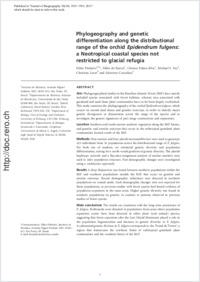Phylogeography and genetic differentiation along the distributional range of the orchid Epidendrum fulgens: a Neotropical coastal species not restricted to glacial refugia
- Pinheiro, Fábio Instituto de Botânica, São Paulo, Brazil - Departamento de Botânica, Instituto de Biociências, Universidade de São Paulo, Brazil
- Barros, Fábio De Instituto de Botânica, São Paulo, Brazil
- Palma-Silva, Clarisse Instituto de Botânica, São Paulo, Brazil
- Fay, Michael F. Jodrell Laboratory, Royal Botanic Gardens Kew, Richmond, UK
- Lexer, Christian Department of Biology, Unit of Ecology and Evolution, University of Fribourg, Switzerland
- Cozzolino, Salvatore Dipartimento di Biologia Strutturale e Funzionale, Università degli Studi di Napoli Federico II, Italy
-
21.06.2011
Published in:
- Journal of Biogeography. - 2011, vol. 38, no. 10, p. 1923–1935
Brazilian Atlantic Forest
Epidendrum
gene flow
genetic structure
microsatellites
Orchidaceae
phylogeography
English
Aim Phylogeographical studies in the Brazilian Atlantic Forest (BAF) have mostly included species associated with forest habitats, whereas taxa associated with grassland and sand-dune plant communities have so far been largely overlooked. This study examines the phylogeography of the orchid Epidendrum fulgens, which occurs on coastal sand dunes and granitic outcrops, in order to identify major genetic divergences or disjunctions across the range of the species and to investigate the genetic signatures of past range contractions and expansions.Location Southern and south-eastern seashore vegetation along the BAF biome, and granitic and arenitic outcrops that occur in the subtropical grassland plant communities located south of the BAF.Methods Nine nuclear and four plastid microsatellite loci were used to genotype 424 individuals from 16 populations across the distributional range of E. fulgens. For both sets of markers, we estimated genetic diversity and population differentiation, testing for a north–south gradient of genetic diversity. The plastid haplotype network and a Bayesian assignment analysis of nuclear markers were used to infer population structure. Past demographic changes were investigated using a coalescence approach.Results A deep disjunction was found between northern populations within the BAF and southern populations outside the BAF that occur on granitic and arenitic outcrops. Recent demographic reductions were detected in northern populations on coastal sands. Such demographic changes were not expected for those populations, as previous studies with forest species had found evidence of population expansion in the same areas. Higher genetic diversity was found in southern populations on granite, in contrast to patterns observed in previous studies of forest species.Main conclusions The results are consistent with the long-term persistence of E. fulgens. Bottlenecks were detected in populations from areas where population expansion events have been detected in other plant (and animal) species, suggesting that forest expansion after the Last Glacial Maximum played a role in the population fragmentation and decrease in genetic diversity in E. fulgens. A substantial genetic division in E. fulgens corresponds to the ‘Portal de Torres’, a region that demarcates the northern limits of subtropical grassland plant communities and the southern limits of the BAF.
- Faculty
- Faculté des sciences et de médecine
- Department
- Département de Biologie
- Language
-
- English
- Classification
- Biological sciences
- License
- License undefined
- Identifiers
-
- RERO DOC 27886
- DOI 10.1111/j.1365-2699.2011.02539.x
- Persistent URL
- https://folia.unifr.ch/unifr/documents/302022
Other files
Statistics
Document views: 109
File downloads:
- lex_pgd.pdf: 290
- lex_pgd_sm.pdf: 77

